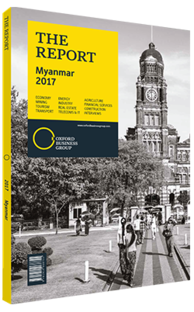Sector plan in Malaysia foresees development of industrial clusters and legislative reform
The new administration of the National League for Democracy (NLD) has highlighted industrial development as a top priority, evidenced by the recent release of a long-term industrial strategy expected to boost the sector’s GDP contribution to nearly 40% over the next 13 years. Under the plan, new investment in key economic corridors will be underpinned by development of industrial clusters, including a host of planned zones for agro-industry, as well as reforms aimed at improving the ease of doing business.
The Ministry of Industry’s industrial strategy calls for expansive, broad-reaching industrial development, with the goal of boosting the industrial sector’s contribution to GDP to 37% by FY 2030/31.
Economic Corridors
The policy identified two geographic areas in which the government will intensify its industrialisation efforts: the southern cities of Yangon and Bago, selected because of their proximity to key road and ocean transport links, as well as relatively developed infrastructure, and the central cities of Mandalay and Sagaing, which have easy access to economic corridors such as the ASEAN Highway Network, a proposed road network which would link Vietnam, Cambodia, Laos, Thailand and Myanmar.
Proposed industrial developments will be further connected to Myanmar’s four economic corridors: north-south, east-west, north-east-south-west and Yangon-Myawaddy, which account for the majority of economic production. The north-south corridor stands as particularly critical, running from Thilawa in Yangon to Myitkyina, via Bago, capital city Nyapyidaw, Meiktila and Mandalay, and encompassing 55% of the country’s GDP and 48% of the population, as well as a special economic zone in Thilawa, 24 industrial zones and seven sub-industrial zones.
Priority Segments
In the near term, the plan focuses on development of labour-intensive industries, including garments and footwear, packaging, wooden furniture, agricultural and fisheries products, and livestock, with an emphasis on adding value. Development of value-added industrial production and a skilled workforce will support mid-term industrial strategies, with the plan emphasising textile dyeing and painting, shipbuilding and manufacturing larger components for automobiles, as well as a long-term goal of establishing advanced industries including semiconductor manufacturing, pharmaceuticals and heavy industry such as metal refining, cement production and petrochemicals.
Promisingly for potential investors, the policy also mentions the possibility of privatising state-owned industrial businesses, as well as the creation of new special agriculture industrial zones. The agricultural zones will focus on value-added processing at sites in Sagaing, Bago, Magwe, Ayeyarwady and Tanintharyi, each specialising on activities tailored to its geography and local strengths (see Agriculture chapter).
Challenges & Reforms
The plan identified 11 main challenges to industrial development, most notably poor transportation infrastructure, inadequate electricity and energy supply, a shortage of skilled labour and high land prices. It calls for the establishment of one-stop shop service centres in each region to facilitate investment, with the centres expected to provide assistance with market research, starting a business and accessing finance.
Perhaps most significantly for potential investors, the policy also includes provisions for the government to confiscate any land in industrial zones that has not been developed for three years or more. According to a July 2016 analysis published by Frontier Myanmar, 7194 plots out of 37,076 in Myanmar’s industrial zones are empty, including 2345 in Yangon, 1464 in Shan State, as well as 1381 in Mandalay.
Electricity concerns, meanwhile, will be mitigated by plans to increase the country’s total installed capacity from its current level of around 2700 MW to 22,720 MW by FY 2030/31 (see Energy chapter).
You have reached the limit of premium articles you can view for free.
Choose from the options below to purchase print or digital editions of our Reports. You can also purchase a website subscription giving you unlimited access to all of our Reports online for 12 months.
If you have already purchased this Report or have a website subscription, please login to continue.

